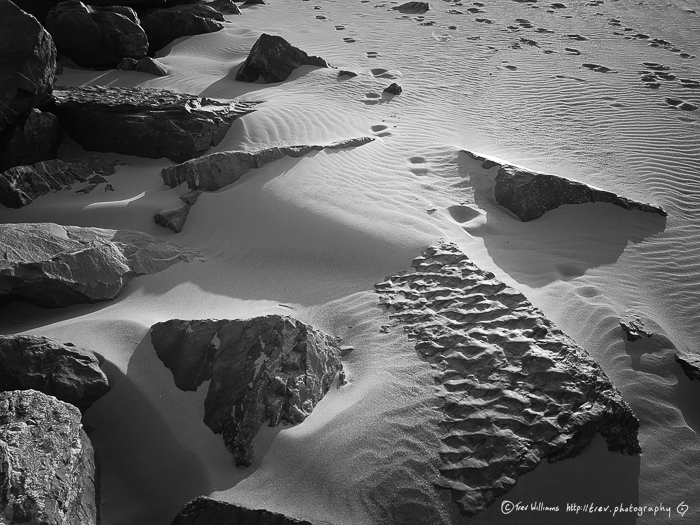I am walking along, looking for things to photograph, like I often do. I'm on the beach. It's one of those bright early spring days where the weather has been calm and sunny for a while, and the sun's rays are strong enough that a brisk wind blowing from the south carries a hint of warm summer days to come.
The sand on the beach has had time to dry out and feels warm to the touch. As I walk barefoot, my feet sink into it, and at each step, a quantity is lifted and scuffed up into little clouds, while the rest spills down between my toes. Childhood memories of lying on a bone-dry beach, watching fistfuls of sand leaking out the gaps between my fingers, come to mind..
I continue my walk. In places, the sand has drifted, gathered up by that steady wind, and heaped in little piles that remind me of the Sahara Desert. In places, it has begun to bury large boulders brought onto the beach by the local council to protect it from scouring Atlantic storms that often make their first landfall here. A few rocks poke out from under these drifts, and one, in particular, draws my eye.
It appears flat with an unnaturally straight edge and lies at a shallow angle like a badly dislodged paving slab. I can see that a thin layer of sand covers some of the stone, thin enough that it still allows a ripple pattern in the rock to show through. Where the sandy veil becomes so thin, fingers of it gather along only the lowest contours of the rock, so that in parts the sand and rock are interlinked, and in places, it’s hard to see a difference between either.
How ironic! In front of me, two sets of ripples. One set of ripples literally cast in stone and the image of enduring permanence; the other set ephemeral, and made of the very thing that we might use to measure the march of time.
Here on the rock, nothing separates them, yet laying between their coming together here, is a tale spanning four hundred million years. It's a story of a mountain range of Himalayan proportions; ground and dissolved down to sand. And how that sand was then blown around and washed by rivers and seas and used to build another range of mountains; the dissolving stumps of which now form the hills that I can see around me, much of the stonework for dwellings and field boundaries, and sand on the beach.
And now, here I am. Watching it happening, right in front of me. The sand moves and I continue my walk.
Why these pictures
The piece I wrote above was a direct response following the printing and framing of this collection of prints. The account itself is a compilation of various experiences at Warren Strand over an 18-month period.
I have a recurring interest in the dynamics of flowing sand and the intricate structures it forms, coupled with a fascination for deep time and the ephemeral nature of being present in a specific moment. Silent reflections on how many times a wave has splashed a particular rock are contemplative exercises I frequently engage in.










